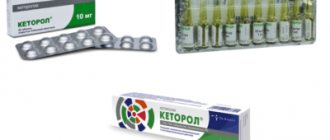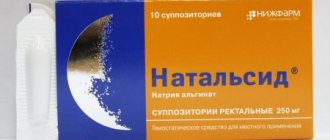Pimafucin is a modern remedy for eliminating fungal infections. The active ingredient of this drug is natamycin, due to which the fight against pathogenic microflora is not only effective, but also fast. It has a wide spectrum of action, so it can be used for a wide variety of diseases. Pimafucin is often prescribed during pregnancy to treat thrush.
Brief description of the drug Pimafucin
The drug has antifungal and antimicrobial effects. It is a product with a wide spectrum of effects. The main component of Pimafucin is natamycin. It is worth noting that natamycin is an antibiotic from the macrolide group. This substance acts on pathogenic microorganisms, destroying them and preventing them from spreading throughout the body.
Among the bacteria on which Pimafucin has a detrimental effect are fungal ones. First of all, these are Candida fungi, which provoke the occurrence of diseases of the female genital organs. The spectrum of action of the drug Pimafucin is:
- Yeast-like bacteria;
- Dermaphrodites;
- Pathogenic microbes.
How it works
Pimafucin is classified as an antimicrobial drug, an antibiotic with a broad antifungal spectrum of action. The active component of the composition, natamycin, has a fungicidal effect on pathogenic microorganisms, binds together all the sterols of the cell membrane of the pathogenic fungus and thus leads to a violation of its integrity, and, accordingly, cessation of functioning. As a result, suppressing their growth and development, preventing the infection from spreading throughout the body.
Pathogenic yeast fungi, especially Candida, are especially sensitive to the main active component of the drug, natamycin. Therefore, it is actively used in the treatment of thrush.
https://youtu.be/W-Z9Bo5XaTI
Indications for use of the drug Pimafucin during pregnancy
Pimafucin during pregnancy is prescribed for the following diseases:
- Infectious diseases caused by fungi sensitive to natamycin;
- Fungal diseases of the gastrointestinal tract, which arose due to decreased immunity due to exhaustion, taking potent drugs such as antibiotics;
- Intestinal candidiasis;
- Mycosis of the ear canal;
- Fungal infections of the skin and appendages (nails), chronic fungal diseases;
- Candidiasis vulvovaginitis (fungal infections of the mucous membranes).
How can you replace Pimafucin while pregnant?
The development of medicine does not stand still, and the pharmaceutical market offers more and more new medications that help expectant mothers cope with thrush. Since a woman is not always satisfied with the price category of Pimafucin or its effectiveness, she can consult a doctor so that he can prescribe a drug that has the same therapeutic effect. Pimafucin has generics similar to it both in composition and indications.
Generics of Pimafucin:
- according to indications, that is, functional: Livarol, Clotrimazole, Terzhinan, Diflucan;
- according to the active substance, that is, structural: Natamycin, Ecofucin.
Table: generics of Pimafucin by composition and indications
| Name of the medication | Release form | Components | Indications for use | Taking the drug by pregnant women | Contraindications | Side effects |
| Structural analogues | ||||||
| Natamycin |
| Natamycin |
| According to the instructions, this medication should be taken only as prescribed by a doctor, when the benefits of its use are much higher than the expected negative consequences. |
|
|
| Ecofucin | Vaginal suppositories | Natamycin |
| The use of the drug should occur under the strict supervision of a physician. | Tendency to allergic reactions to suppository components. | Burning and swelling of the mucous membranes of the labia and vagina. |
| Functional analogues | ||||||
| Livarol | Vaginal suppositories |
|
| Suppositories can be used in the last two trimesters of gestation. | Individual intolerance to the components of the medication. |
|
| Diflucan |
| Fluconazole | The use of oral antifungal drugs is considered inappropriate during gestation. But taking Diflucan is allowed in especially severe cases, when the disease progresses and can cause irreversible consequences for both the mother and the baby. There are known cases of miscarriages and congenital abnormalities of the fetus with long-term use of this drug in the first three months of pregnancy. |
|
| |
| Clotrimazole |
| Clotrimazole | Modern experts do not prescribe medication in the first trimester of gestation. |
|
| |
| Terzhinan | Suppositories and vaginal tablets. |
| The drug is not recommended for use during the first three months of pregnancy. | Hypersensitivity to the active and auxiliary components of the drug. |
|
Forms of Pimafucin
Pimafucin can be purchased in pharmacies in the following forms:
- Vaginal suppositories (suppositories) – in a package there are 3 suppositories at a dosage of 100 mg each;
- External ointment, which has a natamycin concentration of 2% (the structure of the drug is cream);
- Film-coated tablets that dissolve when they enter the intestines (have 100 mg of active substance).
Pimafucin cream is sold in tubes. Each tube contains 30 g of product. Tablets are produced in bottles. Each bottle contains 20 tablets.
The advantage of Pimafucin is that it does not act systemically, therefore there is no adverse effect on the baby. This means that Pimafucin can be used during pregnancy at any stage of gestation; moreover, it is suitable for people of different genders and ages.
Effect of the drug on the fetus
Clinical studies revealed the toxic effect of Natamycin on the unborn child. The drug in high doses can contribute to premature termination of pregnancy and the development of intrauterine growth retardation. However, all forms of Pimafucin are not absorbed into the systemic bloodstream and therefore do not enter the baby’s body.
Attention! Subject to the dosage and rules of administration, all forms of release of the drug Pimafucin are safe for the unborn child.
The use of the drug Pimafucin in the first trimester of pregnancy is possible only if there are strict indications. In the early stages of gestation, the formation of the heart, brain and spinal cord, kidneys and other organs is observed. Taking any medications in the 1st trimester can contribute to the development of congenital pathologies.
The drug can be used in the 2nd and 3rd trimester of pregnancy. At this stage, the placenta performs a good protective function and prevents harmful substances from reaching the fetus. The medication is allowed to be taken until the end of the gestation period; it does not affect the contractile activity of the uterus.
Side effects from the drug
The first days of treatment may be accompanied by nausea and vomiting, and then the side symptoms disappear. Using suppositories or Pimafucin ointment during pregnancy can cause discomfort in the form of burning of the mucous membranes.
As for an overdose of Pimafucin during pregnancy, this rarely happens, since treatment with this drug should be carried out in accordance with the doctor’s recommendations. Pimafucin is well tolerated during pregnancy in most cases, unless you are allergic to the components of the product.
The drug is prescribed even to newborns. It can be combined with any means without fear of a negative reaction.
Side effects
The antifungal drug in question very rarely causes side effects. Often, these reactions from the body are observed with an overdose of the drug. In the case of cream and vaginal suppositories, they manifest themselves in the form of local burning, mild itching, and redness. The listed reactions are observed in the last weeks of pregnancy, when the body's sensitivity is heightened.
Contraindications for use
The instructions for the drug indicate that the main contraindication is sensitivity to the components of Pimafucin. When an allergy occurs, a burning sensation and redness on the mucous membrane occurs.
The drug may cause an exacerbation of toxicosis if you experience its manifestations during pregnancy. In the first days of use, indigestion may appear, but all unpleasant symptoms disappear on their own and no additional treatment is required.
If your body normally tolerates the components of the drug Pimafucin during pregnancy, and the drug itself was prescribed to you by a doctor, then no side effects should occur.
Pimafucin suppositories during pregnancy: instructions
Pimafucin is available in several forms. Most often, treatment with Pimafucin during pregnancy is limited to local measures: the doctor prescribes vaginal suppositories, in which the dosage of the active substance natamycin is 100 mg. The suppository is inserted as deeply as possible into the vagina every day after hygiene procedures and immediately before bedtime. It is best to carry out this procedure while in bed. The candle quickly dissolves, in the process forming foam that covers the mucous membranes with an even layer. Try not to get up so that the vaginal contents do not leak out, because the proper therapeutic effect will not be achieved.
Basically, one course is enough to achieve results. But it also happens that a fungal infection manages to affect not only the vagina, but also the internal organs. In this case, the fungus is localized on the intestinal walls, affecting the genital organs from there. This is the reason for combined treatment, that is, the use of not only suppositories, but also Pimafucin tablets. The drug in tablets is a product containing 20 tablets with a dosage of 100 mg.
Composition, action and release forms
The active ingredient of the drug Pimafucin is the antibiotic natamycin. It acts only locally and is not absorbed into the blood. Its content varies depending on the form of release of the drug.
Pimafucin is available in suppositories, tablets and cream form. For thrush, vaginal suppositories are most often prescribed. If the source of infection is in the intestines, the doctor may supplement the treatment regimen with pills. In such cases, the cream is used when the external genital organs of a woman and her sexual partner are affected by the fungus.
Photo gallery: Pimafucin release forms
Pimafucin tablets are intended for oral administration for intestinal candidiasis Pimafucin cream has a local antifungal effect on the skin and mucous membranes Vaginal suppositories Pimafucin are most often prescribed for thrush
Complex treatment using Pimafucin
Comprehensive treatment of two partners will help to avoid relapse, therefore not only the woman, but also the man should take Pimafucin during pregnancy. In this case, it does not matter at all that a man does not have any symptoms of thrush: the causative agents of the disease can be under the foreskin of the penis and from there migrate to the vaginal mucosa. Thus, the fungus begins to actively multiply.
It is best for a man to undergo preventive treatment using Pimafucin cream, which must be applied twice a day to the mucous membranes and skin. The course of treatment lasts several days after all symptoms of the disease have been eliminated in both partners.
A significant decrease in the body's defenses becomes the cause of oral candidiasis, therefore there is a need to use a suspension that provides local treatment. Although this type of candidiasis is rare.
Is it possible to treat thrush in the first trimester and with what?
Master (1592) 5 years ago There are many ways to treat thrush during pregnancy with folk remedies. The most popular of them are washing the genitals with saline solution, a decoction of oak bark, a solution of sodium tetraborate in glycerin, calendula baths, etc. This treatment can help get rid of the symptoms of thrush during pregnancy, but the effect will be short-lived. Here is one such method for treating thrush during pregnancy. Many old-school gynecologists still recommend it as the fastest way to get rid of this unpleasant disease. Pour a tablespoon of soda into 1 liter of water and add 1 teaspoon of iodine. Pour the resulting solution into a basin and sit in it for about 20 minutes. Perform the procedure once a day for 2-3 days. Yogurt. Lactic acid bacteria ferment milk into yogurt. The simplest method is to insert 1-2 tablets of yogurt into the vagina at night. As an alternative treatment for thrush, you can use a vaginal applicator to insert 1 to 2 tablespoons of plain, unsweetened yogurt into your vagina. Or, dissolve 2 tablespoons of yogurt in 1 cup of warm water and use this solution as a rinse, applying it in the same way as the vinegar rinse described earlier in this section. Whatever treatment for thrush you use, the procedure should be carried out once a day for 1-2 weeks. If the cause of the infection is the use of antibiotics, you should wait until the end of the course of taking them, and then drink 2 tablespoons of yogurt about half an hour before each meal for a week. Vitamins. Some women with persistent thrush report remarkable results after taking 100 mg of vitamins B, , B2, B6 and 200 mg of vitamin B3 along with pantothenic acid and the rest of the complex when eating foods high in B vitamins. The indicated large dosage of vitamins should be taken for 2 months and then gradually reduce. Pantothenic acid and vitamin B6 stimulate the production of antibodies and leukocytes. Also take at least 1000 mg of vitamin C per day to stop the infection and make the bacteria harmless and prevent further growth of harmful bacteria. Take additional vitamins A and E for 3 days with meals. Vitamin A is vital for maintaining healthy mucous membranes, and vitamin E protects vitamin A. Diet. Some women have noticed that eating large amounts of meat, dairy products, grains and sugar (including honey) makes thrush worse. Eating a diet primarily consisting of fruits and vegetables for 2-3 weeks can be an excellent treatment for thrush. The rest of the answers
Analogues of the drug Pimafucin during pregnancy
Analogues of a drug are those drugs that have a similar effect on the body. The main differences are the manufacturer and price.
Anatogis of Pimafucin: Funzol, Fungavist, Tsiskan, Primafungin, Funginok, Zinkundan, Fungizon.
Each of these products can be purchased at a pharmacy without a prescription. Replacing the drug Pimafucin during pregnancy with another drug is possible only after prior consultation with a doctor and examination by a specialist.
Reviews of the drug Pimafucin during pregnancy
- Darina Surkova, 25 years old. An exacerbation of candidiasis occurred when I was 5 months pregnant. Previously, thrush had already made itself felt, and I was able to get rid of it, but now, during the period of pregnancy, candidiasis appeared again. This happened on the second day after my birthday: apparently, I overdid it with sweets, and as a result, burning and itching appeared. I had to rush to the doctor, who prescribed me vaginal suppositories Pimafucin. The gynecologist said that the drug would not harm me and would not have a negative effect on the baby. Of course, I had a little doubt and was worried whether it was worth using Pimafucin at such a late date, so I decided to go to the Internet, where I read a lot of reviews and got acquainted with the information on the medical portal. The information that I was able to obtain was quite positive: expectant mothers talked about Pimafucin as a remedy that is actually the only one acceptable for use during pregnancy. As a result, I bought Pimafucin and panty liners, since the product leaks a little. I will say that candles are fragile, so they should be carefully removed from the packaging. I felt relief after use on the second day: the itching and burning disappeared, and there was a significant improvement in my condition. After the course of treatment, all symptoms disappeared. Pimafucin helped, and the birth went without complications.
- Anya Mylnikova, 36 years old . I have used the drug before. This is not the first time that I have used Pimafucin to get rid of thrush: this happened during my previous pregnancy. The product does its job well and does not cause side effects. Inserting candles will not be difficult, the only drawback is that the candles melt and leak a little, but this is not the worst thing. During my first pregnancy, the doctor prescribed Pimafucin to me, and while carrying my second child, I started taking it on my own. After childbirth, the symptoms of thrush recurred, but then disappeared after the body was completely restored. Considering that the product is safe and effective, then the price of Pimafucin is quite justified.
- Svetlana Zaitseva, 30 years old. I bought Pimafucin immediately after I noticed manifestations of candidiasis. This happened at week 12, when after treatment with another drug I did not see any results. The cost of the product is quite impressive, but after consulting with the doctor, I decided to take Pimafucin. I bought 6 candles at the pharmacy and used them before bed for 6 days in a row. There were no side effects, and a week later I took a smear: it turned out to be clean.
- Varvara Yakovleva, 28 years old. Thrush appeared in the first weeks of pregnancy. I didn’t put off visiting the doctor, so I immediately sought a consultation. The doctor said that no action needs to be taken until the 12th week, and from the 13th week I started using Pimafucin suppositories. Three days after the start of treatment, the burning sensation began to decrease, and after 6 days, the thrush disappeared completely. My baby will be born soon, I don’t feel any suspicious symptoms, thanks to the doctor and the drug.









